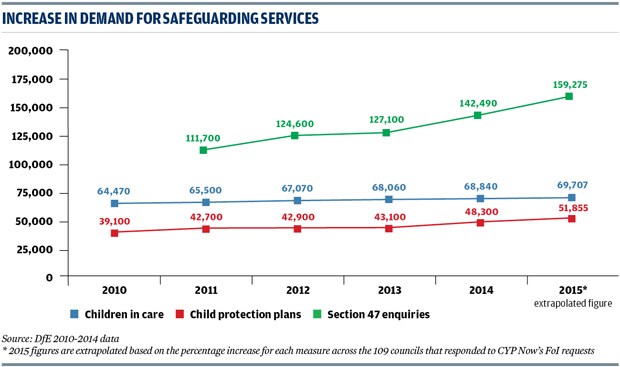Massive rise in number of children in care under coalition
Neil Puffett
Monday, June 22, 2015
The number of children being cared for by the state rose by more than 5,000 during the term of the coalition government, an investigation by CYP Now has found.

A freedom of information request to local authorities found that, of the 109 councils that responded, the number of children in care increased 1.26 per cent between March 2014 and March 2015.
Extrapolated across all local authorities in England, the findings indicate that the number of children in care rose from 64,470 in March 2010 to 69,707 in March 2015 – a rise of 5,237, or 8.1 per cent.
Meanwhile, the number of vulnerable children placed on child protection plans – put in place by children’s social work teams to try to ensure their safety – rose by close to a third (32.6 per cent) under the coalition – from 39,100 as of March 2010, to 51,855 as of March 2015.
And the number of Section 47 enquiries – which are conducted by social work teams to decide whether children are at risk of abuse or neglect – increased by 42.5 per cent from 111,700 in 2010/11 to 159,275 in 2014/15.
The figures, which are due to be collected by the Department for Education and officially published in the autumn, indicate that children’s social work teams are coming under increasing pressure.
Alison O’Sullivan, president of the Association of Directors of Children’s Services (ADCS), described the increases as “worrying”.
She said that while the expectation is that figures will eventually plateau, that depends on the “underlying causes” driving the increases.
A previous spike in care demand occurred following publication of a serious case review in 2009 into the death of Baby Peter Connelly and subsequent media coverage – the so-called "Baby P effect".
Experts said the case heightened awareness of child protection issues among the general public.
But O'Sullivan thinks the increases under the coalition government could be linked to other factors.
She points to the ongoing austerity drive, and increases in the number of children and young people resident in England.
“One of the causes not talked about often is that as the population grows, there are greater numbers of children,” she said.
“There is clearly also a link between deprivation and pressures in communities.
“At the moment, we are seeing the effects of austerity and some of the system reform is creating additional pressures for families – particularly the poorest members of society.”
Andy Elvin, chief executive of The Adolescent and Children’s Trust, said it is likely that the rises in Section 47 enquiries and child protection plans have resulted in increasing caseloads for children’s social workers.
“If it is leading to higher caseloads, how safe is that and what does it mean for the retention of social workers?” he said.
“If you are in a highly pressurised workplace and you get more work, it could make you less likely to stay.
“The figures make the case for increased investment in frontline child protection and permanency services.”
A DfE spokesman said: ?“There has been a long-running growth in demand for children’s social care in recent years as the population has increased.
“However, we know that councils are working hard to meet this demand – and more children are getting the targeted help they need.”
Enver Solomon, director of evidence and impact at the National Children's Bureau, said children’s social care is under "considerable strain" as demand increases from families who are struggling to cope and children who are in need of care and protection.
"This is perhaps not surprising given the rise in child and family poverty," he added.
"So far local authorities have been able to protect the provision of their statutory services and have looked at how practice can be reformed and new ways of working.
"But if demand continues to rise and further cuts are made this will become much harder.
"In the immediate future it is critical that government recognises that resource must keep up with demand as well as encouraging further innovation.
"In longer term, however, there needs to be a more fundamental rethinking of how as a society we keep children safe from abuse and harm, that is led by the sector rather than government."
To read the full analysis click here.





